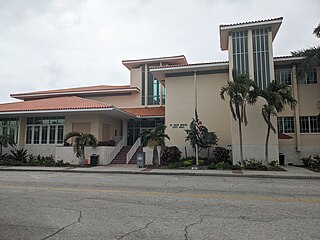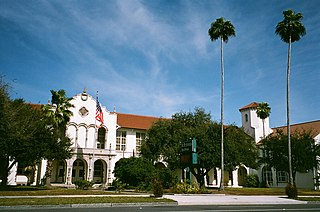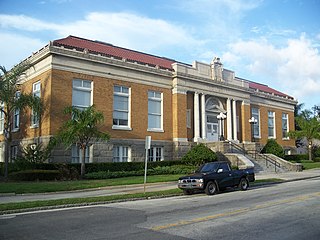
Pinellas County is a county located on the west central coast of the U.S. state of Florida. As of the 2020 census, the population was 959,107, making it the seventh-most populous county in the state. It is also the most densely populated county in Florida, with 3,491 residents per square mile. The county is part of the Tampa–St. Petersburg–Clearwater Metropolitan Statistical Area. Clearwater is the county seat. St. Petersburg is the largest city in the county, as well as the largest city in Florida that is not a county seat.

St. Petersburg is a city in Pinellas County, Florida, United States. As of the 2020 census, the population was 258,308, making it the fifth-most populous city in Florida and the most populous city in the state that is not a county seat. It is the second-most populous city in the Tampa Bay area, which is the second-largest metropolitan area in Florida with an estimated population of about 3.29 million in 2022.

Clearwater is a city and the county seat of Pinellas County, Florida, United States, west of Tampa and north of St. Petersburg. To the west of Clearwater lies the Gulf of Mexico and to the southeast lies Tampa Bay. As of the 2020 census, the city had a population of 117,292. It is the smallest of the three principal cities in the Tampa–St. Petersburg–Clearwater metropolitan area, most commonly referred to as the Tampa Bay area.

Dunedin is a city in Pinellas County, Florida, United States. The name comes from Dùn Èideann, the Scottish Gaelic name for Edinburgh, the capital of Scotland. Dunedin is part of the Tampa–St. Petersburg–Clearwater metropolitan area and is the fifth largest city in Pinellas County. The population was 36,068 as of the 2020 census.

Largo is the third largest city in Pinellas County, Florida, United States, as well as the fourth largest in the Tampa Bay area. As of the 2020 Census, the city had a population of 82,485, up from 77,648 in 2010.

Pinellas Park is a city located in central Pinellas County, United States. The population was 53,093 at the 2020 census. The city is the fourth largest city in Pinellas County. The City of Pinellas Park was incorporated in 1914. It is part of the Tampa–St. Petersburg–Clearwater Metropolitan Statistical Area, most commonly referred to as the Tampa Bay Area.

St. Pete Beach is a coastal city in Pinellas County, Florida. Known as a tourist destination, St. Pete Beach was formed from the towns of Pass-a-Grille, Belle Vista, St. Petersburg Beach, and unincorporated Pinellas County. It is part of the Tampa Bay area. The population was 8,879 at the 2020 census.

This is a timeline of history of the city of Largo, Florida, United States.

Timeline of Pinellas County, Florida history.

St. Petersburg High School, founded in 1898, is a secondary school in the Pinellas County School District in St. Petersburg, Florida. The school's current building, a historic landmark, was built in 1926. It was designed by Missouri architect William B. Ittner. It was listed on the National Register of Historic Places in 1984. The school was billed as the nation's first million dollar high school. The school previously occupied several other historic locations around St. Petersburg, including a location at Mirror Lake (1919–1926).

The Greater Victoria Public Library (GVPL) is a public library that serves Victoria, British Columbia and the surrounding area.

For other Carnegie Libraries, see Carnegie library (disambiguation)

The Largo Public Library is a public library located in Largo, Florida, United States. Located next to Largo Central Park, it serves a community of over 75,000 residents.
The Tampa–Hillsborough County Public Library System (THPL) is a public library system based in Hillsborough County, Florida, United States. It is part of two larger library networks, the Tampa Bay Library Consortium, and the Hillsborough County Public Library Cooperative, which includes Temple Terrace Public Library in Temple Terrace, and Bruton Memorial Library in Plant City. There are 33 branches of the Hillsborough County Public Library Cooperative.

The James Weldon Johnson Community Library is a public library located in St. Petersburg, Florida. It is a branch of the St. Petersburg Library System, which services a large area in southern Pinellas County, Florida.
The St. Petersburg Library System is a free public library system for residents of the city of St. Petersburg, Florida, located in Pinellas County. The St. Petersburg Library System is part of the Pinellas Public Library Cooperative and consists of 7 branch locations.
The following is a timeline of the history of the city of St. Petersburg in Pinellas County, Florida, United States.

The Clearwater Public Library System (CPLS) is a public library system with five branches that provides service to the citizens of Clearwater, Florida and Pinellas County. The library system was founded in 1911. It is a member of the Pinellas Public Library Cooperative.
The Manatee County Public Library is a public library that provides services and resources to the communities and visitors of Manatee County. It is a division of the Manatee County Government's Community and Veterans Services Department located in Manatee County, Florida. The library system provides patrons with in-person resources such as books, movies, and music, as well as online databases to access e-books, e-audiobooks, journal articles, magazines, and other resources. Library services include free events for the public, one-on-one learning sessions, and computers and other technological equipment available for public use. Library cards are provided at no charge to those who reside, own property, attend school, or work in Manatee County.

The North Greenwood Library is a public library in the North Greenwood neighborhood of Clearwater, Florida. It is part of the Clearwater Library System which, in turn, is part of the Pinellas Public Library Cooperative. Located at 905 N Martin Luther King Jr. Ave, its current Branch Manager is Christa Smith.



















